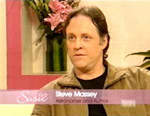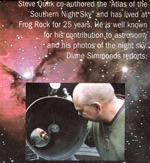* Info about our other book,  Deep Sky Video Astronomy *
Deep Sky Video Astronomy *



Reviews and media coverage of the first edition published in 2007
...more popular than the "Celestial Home care Omnibus", better selling than "53 more things to do in zero gravity" and more controversial than Oolon Colluphid's trilogy of philosophical blockbusters... DON'T PANIC ! ...
Hitchhikers Guide to the Galaxy.
Radio Interviews on:
ABC National - The Idlers, 2UE - George and Paul, 2NSB - Barry Eaton, 4GR - Graham Healy, 2RE - Craig Hooth, 2ST - Graham Day, 4BC - Robyn Maguire, Sport 927 - Trevor Hemsted, ABC - South Australia, ABC - North Queensland.
Newspaper Reviews or Featured in:
Australian
Sky & Telescope magazine - Sep/Oct 2007,
Daily Telegraph (Sydney) - Tue 7th Aug 2007,
The Age (Melbourne Victoria) - Mon 13th Aug 2007,
Mudgee Guardian (see
below) - Mon 13th Aug 2007,
Mudgee Weekly - Wed 15th Aug 2007,
The Land - Thur 13th Sep 2007,
Manly Daily - Sat 15th Sep 2007,
Daily Examiner (Grafton) - Sat 22nd Sep 2007,
Townsville Bulletin - Wed 17th Oct 2007,
Bay Post (Ulladulla) (see below) - Fri 12th Oct 2007.
Websites:
IceInSpace
forum
The singleparent Bible
Cloudy Nights
Telescope Reviews
On TV:
WIN TV - Susie Elelman - Tue 28th Aug 2007


Steve Massey telling Susie about the upcoming Lunar Eclipse and using illustrations in Atlas
of the Southern Night Sky to show how an eclipse works. 28th August 2007


Profile of Mudgee's new local author by Diane Simmonds.
Images courtesy Mudgee Guardian Monday 27th August.


Steve Massey with his Maksutov Equatorial Telescope.
Appeared in the 'weekend' section of the Manly Daily.
Moongazing passion written by John Morcombe.
Testimonials - Reviews"
When I first picked up this book, I was particularly impressed by the quality of the
publication. The binding, quality of paper, and general appeal was that of a book that I
would assume to be sold at around double its price. Later, when I studied it more closely,
it came home. This is the book that we've all been waiting for!
I regard myself as a "hobbyist". I have been looking skyward at night for some 45 years and
have owned many telescopes, and still own too many!) and consequently many "Star Atlases".
The norm is that you pay a lot of money for a slim volume with a lot of pokey charts and a
cursory regard to the Southern Hemisphere. It is so refreshing to find an atlas that is well
produced, well written, well illustrated, and dedicated solely to us in the Antipodes (and
entirely Australian).
Moreover, this Atlas would be user friendly to anyone at entry level, but still provides
enough info to satisfy the most experienced "astronomer" using relatively small tubes in the
field (and lets face it, few of us can afford big scopes, and when the night sky is a hobby,
and you are not a Scientist, well you don't get time on the big ones)
Particularly pleasing is the non inclusion of objects of a magnitude too small to see by the
average home user, as these things tend to clutter charts up (and perhaps raise false
expectations?) and I really enjoyed the little "tips" that pop up at various pages.
Well done to the two "Steves". Now that you have given us something Australian.
Vince Legge (QLD)
Extract from BOOKSELLER & PUBLISHER September 2007
Peta Layton imagines novice astronomers will get excited about the release of Atlas of the Southern Night Sky (New Holland) which she said is 'good for Australia as most of the atlases are for the Northern Hemisphere.'
Extract from Mudgee Guardian Newspaper Mon 13th August 2007
An Excellent book for budding astronomers to learn from...
At last, a high quality book for amateur astronomers that deals primarily with the night sky as viewed from the Southern Hemisphere. Written by amateur astronomer Steve Massey and local Mudgee amateur astronomer, Steve Quirk, this book is the result of decades of experience by the authors in both observational and photographic astronomy. It is presented in a language that is easy to understand by the novice in astronomy as well as the seasoned observers who will find it a handy addition to their library. The foreword of the book is written by Dr Fred Watson from the Anglo-Australian Observatory at Coonabarabran and the fact that he has agreed to be associated with this publication is a great recommendation indeed for the book.
The first few pages deal with a quick and simple introduction to the visible universe with brief references to sky phenomena such as the Zodiacal Light and Aurora Australis. Complimenting its southern feel, the accompanying auroral photographs by Stephen Voss from New Zealand really help to bring these pages to life. There are also short articles on other subjects that will be interesting for the beginner in astronomy as well as a simple means of measuring visual distances between objects in the night sky using your hand held at arm's length. This part of the book gives an explanation on the makeup of stars and briefly covers such objects as Globular Clusters, Open Clusters and the many different types of Nebulae of interest to the amateur astronomer. Many of these explanations are accompanied by photographs of the mentioned objects making this part of the book very easy to understand.
The next section, taking up 60% of the book, consists of star maps and maps of the constellations visible from mid-southern latitudes. These maps are printed on a dark blue background overlaid with white stars. This makes them very easy to read in the dark when illuminated by faint red light which is used to preserve the eye's dark adapted vision. Each constellation chart is accompanied by a list of the deep sky objects that are within the reach of moderate sized amateur telescopes and binoculars. Their catalogue numbers and coordinates are supplied, as well as photographs of some. There is also an explanation on each of these objects stating just what the object is, its brightness and its distance from the Earth. Among these pages can also be found many words of wisdom on such things as setting up for an observing session, star party etiquette and hints on observing faint objects.
There then comes a section covering the Solar System with a comprehensive collection of moon maps accompanied by a Table of Lunar Features, making it easy to identify many of The Moon's most prominent highlights. The information given in the planetary pages is precise and easy to understand with some handy hints on the type of filters to use to bring out the surface features of each of these distant worlds. This section also covers comets and meteors with a great composite photograph of the October 2006 Orionid meteor shower.
The chapter on telescopes covers the basic optical systems of the most common instruments likely to be used by the amateur astronomer and also covers briefly some of the accessories which can be used with these telescopes such as mounts, eyepieces and filters. There are a few pages in the last section of the book that give an insight into some aspects of astrophotography. Any amateur astronomer aspiring to start photographing the night sky should find this part of the book of interest.
To sum up, I must say that I find this to be a great publication and one that has been long overdue here in the Southern Hemisphere. It is extremely well laid out and can be used at the telescope as a reference or general read while relaxing between observing sessions. The content is highly informative and the photographs, which have obviously been taken over the past several years, are great. It is written in a way that the non-scientific beginner will have no trouble understanding and will encourage more people to get out and enjoy and better understand the night sky. With its very attractive cover this book just begs to be taken down from the bookcase and read. Congratulations to the authors who obviously have the passion for amateur astronomy and are keen to pass it on.
Reviewed by John Vetter - Mudgee Observatory
Extract from Bay Post (Ulladulla) Friday 12th October 2007
Look to the stars
One of my favourite father/son bonding sessions,
when my boy was a young 'un, was to lie out on the sweet grass in our backyard and watch the
night sky.
Now my son is 25 and working on a station in the Northern Territory. He has told me that one
of the most outstanding things about working in the outback is lying on his swag and
watching the sky ... no sounds of traffic, no electricity noise, only the bellowing of an
occasional cow or the snuffling of one of the camp horses.
I can also remember watching Halley's Comet from a national park perched on the side of a
mountain. More recently, I ventured out in the cold to see the magnificent Lunar eclipse
when the moon became a fiery red ball in the sky.
There are lots of things that money can't buy and watching the stars is one of them. For the
more adventurous and hardy souls, there are some wonderfully powerful telescopes to purchase
and I envy those who have them.
This atlas will help any amateur stargazer to identify and photograph stars; delight you
with the images of some beautiful objects from our heavens; and help you to pick out
constellations which are right above us.
This is a great book to have somewhere handy for stargazing on a clear night and with spring
and summer weather coming our way, you won't have to freeze to enjoy them.
From Habitat Australia October 2007

Return to main page
Steve Massey's Video Astronomy pages